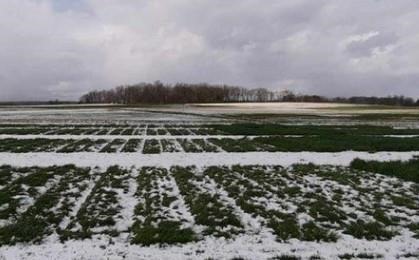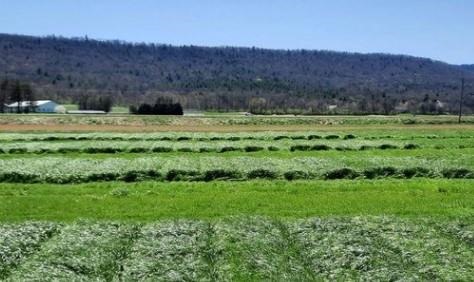By Tyler Rice


This is the same annual ryegrass trial, photos taken 10 days apart, April 19 (top photo) and April 29 (bottom photo). (Photo credit: Tyler Rice, Penn State)
Are you a producer seeking variety information on fall-planted, spring harvested forages? Are you hoping to harvest the rewards of planting a cover crop that has tangible forage value in the Spring? If this sounds like you, you will want to see the latest results of Short-Lived Grass, Winter Forage, and Cover Crops trials conducted by the Penn State Forage Variety Evaluation Program.
These series of trials are typically planted in mid to late September. In the Spring the trials are divided by harvest approach. In the single-cut system, varieties are selectively harvested at mid to late boot stage to achieve an optimum balance between forage yield and forage quality. In a multi-cut system, varieties are harvested earlier (approximate flag leaf, with a target height of 20 inches). Both of these systems demonstrate the ability to grow a quality crop that adds value in the margins of the season in order to maximize field and farm potential, doing more with less!
Classes of species in these particular trials include the following: Annual Ryegrass (both Single and Multi-cut approach), Timothy-as-an-annual, Cereal Rye, Triticale, Barley, and Mixed Species. The detailed information can be found in the " Short-Lived Grass, Winter Forage and Cover Crops trial results 2021-2022 ".
Please keep in mind when reviewing the yield and stand tables that differences between varieties are significant only if the least significant difference (LSD) between varieties is exceeded. LSD is the minimum difference between any two varieties necessary for us to be 95 percent confident that this difference is not attributable to mere chance. For example, if variety A is 0.50 ton/acre higher in yield than variety B, then this difference is statistically significant if the LSD is 0.50 or less. If the LSD is 0.51 or greater, then we cannot be confident that variety A really yields higher than B under given environmental and management conditions.
The value for coefficient of variation (CV) is a measure of relative variation useful in evaluating the precision achieved in an experiment. In grain and forage trials, for example, the CV for yield often is between 5 and 20 percent. Acceptable levels of the CV vary for each trait measured. Confidence in the reliability of the experimental results declines as the CV increases. Uncontrollable or immeasurable variations in soil fertility, soil drainage, and other environmental factors contribute to increased CV levels.
Source : psu.edu